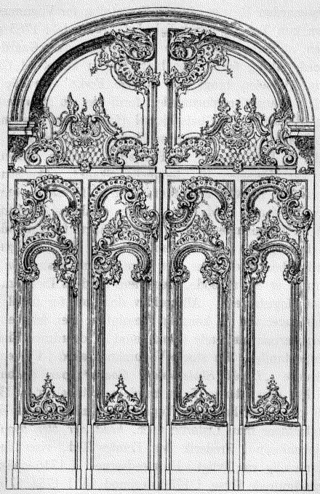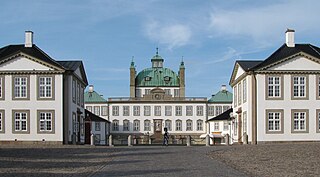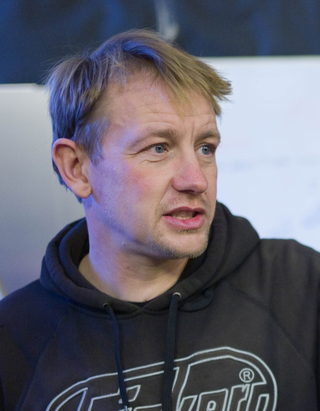
Prince Henrik of Denmark was the husband of Margrethe II of Denmark. He served as her royal consort from Margrethe's accession on 14 January 1972 until his death on 13 February 2018.

Christiansborg Palace is a palace and government building on the islet of Slotsholmen in central Copenhagen, Denmark. It is the seat of the Danish Parliament, the Danish Prime Minister's Office, and the Supreme Court of Denmark. Also, several parts of the palace are used by the Danish monarch, including the Royal Reception Rooms, the Palace Chapel and the Royal Stables.

Count Nikolai of Monpezat is a member of the Danish royal family. He is the eldest son of Prince Joachim and his first wife, Alexandra, Countess of Frederiksborg, and eldest grandchild of Queen Margrethe II. He is currently seventh in the line of succession to the Danish throne. At the time of his birth, he was third, after his uncle and father.

Nicolai Eigtved, also known as Niels Eigtved was a Danish architect. He introduced and was the leading proponent of the French rococo or late baroque style in Danish architecture during the 1730s–1740s. He designed and built some of the most prominent buildings of his time, a number of which still stand to this day. He also played an important role in the establishment of the Royal Danish Academy of Art, and was its first native-born leader.

Nicolas-Henri Jardin was a French architect. Born in St. Germain des Noyers, Seine-et-Marne, Jardin worked seventeen years in Denmark–Norway as an architect to the Danish royal court. He introduced neoclassicism to Denmark–Norway.

Fredensborg Palace is a palace located on the eastern shore of Lake Esrum in Fredensborg on the island of Zealand (Sjælland) in Denmark. It is the Danish Royal Family’s spring and autumn residence, and is often the site of important state visits and events in the Royal Family. It is the most used of the Royal Family’s residences.

The Danish Palaces egg is an Imperial Fabergé egg, one of a series of fifty-two jeweled eggs made under the supervision of Peter Carl Fabergé for the Russian Imperial family. It was crafted and delivered to the then Tsar of Russia, Alexander III who presented it to his wife, Maria Feodorovna on Easter day 1890. The egg is currently owned by the Matilda Geddings Gray Foundation and housed in the Metropolitan Museum of Art in New York City, New York.

The architecture of Denmark has its origins in the Viking period, richly revealed by archaeological finds. It became firmly established in the Middle Ages when first Romanesque, then Gothic churches and cathedrals sprang up throughout the country. It was during this period that, in a country with little access to stone, brick became the construction material of choice, not just for churches but also for fortifications and castles.

Frederiksberg is a part of the Capital Region of Denmark. It is formally an independent municipality, Frederiksberg Municipality, separate from Copenhagen Municipality, but both are a part of the City of Copenhagen. It occupies an area of less than 9 km2 and had a population of 103,192 in 2015.

North Zealand, also North Sealand, refers to the northern part of the Danish island of Zealand which is not clearly defined but generally covers the area north of Copenhagen. The Danish tourist authorities have recently introduced the term Danish Riviera to cover the area in view of its increasing importance for tourism. The area has three royal castles and offers resorts with beaches, as well as lakes and forests. In addition to Kronborg Castle, three of the North Zealand forest areas used for royal par force hunting are included in the UNESCO World Heritage List.
Johan Ludvig Mansa, was a German-Danish landscape gardener. The majority of his work was in transforming formal French gardens into English landscape gardens. Some remnants of his works can still be seen on the slope north of Marienlyst Castle in Helsingør as well as a few manors and palaces around Denmark.

Marienlyst Castle is a palatial residence located in Helsingør, Denmark. It was named after King Frederik V of Denmark's second wife, Juliana Maria, the queen consort of Denmark and Norway. The building formerly served as a royal pavilion of Kronborg Castle and was mostly used as a venue for pleasure and hunting. It was also used by the director-general of the Øresund Custom House, Colonel Adam Gottlob von Krogh and his wife Magdalene, between 1796 and 1847.

Jacob Fortling was a German-Danish sculptor, architect and industrialist, described as one of the most industrious people in the Denmark of his day. He came to Denmark at age 18 and embarked on a successful career, first as a sculptor and later also as an architect. He was also engaged in the production of building materials, owning several quarries in Norway. Just outside Copenhagen, on Amager's east coast, he founded Kastrup Værk, a large industrial facility combining a lime plant, a brickyard and a pottery.
Sven Julius Risom was a Danish architect who worked mainly in the style of Nordic Classicism.

Johan Cornelius Krieger (1683–1755) was a Danish architect and landscape architect, who from the 1720s served as both the country's chief architect, and head of the royal gardens.

Peter Langkjær Madsen is a Danish convicted murderer and former entrepreneur. In April 2018, he was convicted of the 2017 murder of Swedish journalist Kim Wall on board his submarine, UC3 Nautilus, and sentenced to life imprisonment.

The Fredensborg Houses form a housing complex in natural surroundings on the outskirts of the small town of Fredensborg in the north of Zealand, Denmark. The houses were designed by Jørn Utzon for Danes who have worked for long periods abroad.

The Bournonville House, located at Slotsgade 9, the main access road to Fredensborg Palace, is the former summer residence of choreographer August Bournonville in Fredensborg, some 30 km north of Copenhagen, Denmark. The building was listed in the Danish registry of protected buildings and places in 1918.

Michael Rosings Minde, Helsingørsvej 3, is a house in Fredensborg, Denmark. It was built in 1873 to designs by Johan Daniel Herholdt. It was listed in the Danish registry of protected buildings and places in 1980.


















